Machine Learning project
Contents
Machine Learning project#
This notebook is a short version of the end-to-end Machine Learning project provided by Aurélien Geron.
Setup#
This project requires:
Python 3.7 or above
Scikit-Learn ≥ 1.0.1:
%matplotlib inline
import sys
from pathlib import Path
import numpy as np
import pandas as pd
from pandas.plotting import scatter_matrix
import matplotlib.pyplot as plt
import sklearn
from sklearn import set_config
set_config(display='diagram')
plt.rc('font', size=14)
plt.rc('axes', labelsize=14, titlesize=14)
plt.rc('legend', fontsize=14)
plt.rc('xtick', labelsize=10)
plt.rc('ytick', labelsize=10)
# Check if you have the correct versions
assert sklearn.__version__ >= "1.0.1"
assert sys.version_info >= (3, 7)
Data#
Welcome to Machine Learning Housing Corp.! Your task is to predict median house values in Californian districts, given a number of features from these districts.
housing = pd.read_csv("https://raw.githubusercontent.com/kirenz/datasets/master/housing_hml3.csv")
Overview#
housing.head()
| longitude | latitude | housing_median_age | total_rooms | total_bedrooms | population | households | median_income | median_house_value | ocean_proximity | |
|---|---|---|---|---|---|---|---|---|---|---|
| 0 | -122.23 | 37.88 | 41.0 | 880.0 | 129.0 | 322.0 | 126.0 | 8.3252 | 452600.0 | NEAR BAY |
| 1 | -122.22 | 37.86 | 21.0 | 7099.0 | 1106.0 | 2401.0 | 1138.0 | 8.3014 | 358500.0 | NEAR BAY |
| 2 | -122.24 | 37.85 | 52.0 | 1467.0 | 190.0 | 496.0 | 177.0 | 7.2574 | 352100.0 | NEAR BAY |
| 3 | -122.25 | 37.85 | 52.0 | 1274.0 | 235.0 | 558.0 | 219.0 | 5.6431 | 341300.0 | NEAR BAY |
| 4 | -122.25 | 37.85 | 52.0 | 1627.0 | 280.0 | 565.0 | 259.0 | 3.8462 | 342200.0 | NEAR BAY |
housing.info()
<class 'pandas.core.frame.DataFrame'>
RangeIndex: 20640 entries, 0 to 20639
Data columns (total 10 columns):
# Column Non-Null Count Dtype
--- ------ -------------- -----
0 longitude 20640 non-null float64
1 latitude 20640 non-null float64
2 housing_median_age 20640 non-null float64
3 total_rooms 20640 non-null float64
4 total_bedrooms 20433 non-null float64
5 population 20640 non-null float64
6 households 20640 non-null float64
7 median_income 20640 non-null float64
8 median_house_value 20640 non-null float64
9 ocean_proximity 20640 non-null object
dtypes: float64(9), object(1)
memory usage: 1.6+ MB
housing["ocean_proximity"].value_counts()
<1H OCEAN 7274
INLAND 5301
NEAR OCEAN 2089
NEAR BAY 1846
ISLAND 2
Name: ocean_proximity, dtype: int64
housing.describe().T
| count | mean | std | min | 25% | 50% | 75% | max | |
|---|---|---|---|---|---|---|---|---|
| longitude | 16512.0 | -119.573125 | 2.000624 | -124.3500 | -121.8000 | -118.5100 | -118.01 | -114.4900 |
| latitude | 16512.0 | 35.637746 | 2.133294 | 32.5500 | 33.9300 | 34.2600 | 37.72 | 41.9500 |
| housing_median_age | 16512.0 | 28.577156 | 12.585738 | 1.0000 | 18.0000 | 29.0000 | 37.00 | 52.0000 |
| total_rooms | 16512.0 | 2639.402798 | 2185.287466 | 2.0000 | 1447.0000 | 2125.0000 | 3154.00 | 39320.0000 |
| total_bedrooms | 16344.0 | 538.949094 | 423.862079 | 1.0000 | 296.0000 | 434.0000 | 645.00 | 6210.0000 |
| population | 16512.0 | 1425.513929 | 1094.795467 | 3.0000 | 787.0000 | 1167.0000 | 1726.00 | 16305.0000 |
| households | 16512.0 | 499.990189 | 382.865787 | 1.0000 | 279.0000 | 408.0000 | 603.00 | 5358.0000 |
| median_income | 16512.0 | 3.870428 | 1.891936 | 0.4999 | 2.5625 | 3.5385 | 4.75 | 15.0001 |
housing.hist(bins=50, figsize=(12, 8));
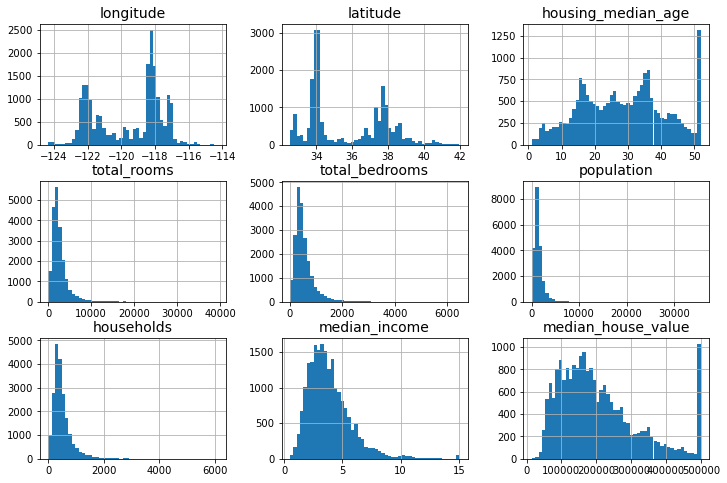
Data split#
housing["income_cat"] = pd.cut(housing["median_income"],
bins=[0., 1.5, 3.0, 4.5, 6., np.inf],
labels=[1, 2, 3, 4, 5])
housing["income_cat"].value_counts().sort_index().plot.bar(rot=0, grid=True)
plt.xlabel("Income category")
plt.ylabel("Number of districts");
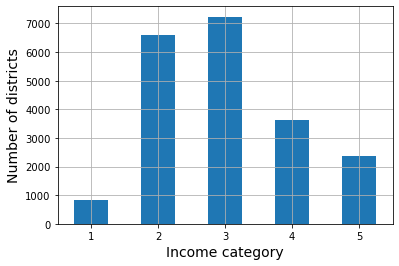
Stratified split:
from sklearn.model_selection import train_test_split
strat_train_set, strat_test_set = train_test_split(
housing, test_size=0.2, stratify=housing["income_cat"], random_state=42)
Drop the variable “income_cat” from our datasets:
for set_ in (strat_train_set, strat_test_set):
set_.drop("income_cat", axis=1, inplace=True)
Exploration#
housing = strat_train_set.copy()
Visualizing Geographical Data#
housing.plot(kind="scatter", x="longitude", y="latitude", grid=True);
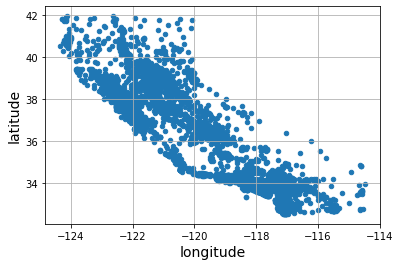
housing.plot(kind="scatter", x="longitude", y="latitude", grid=True, alpha=0.2);
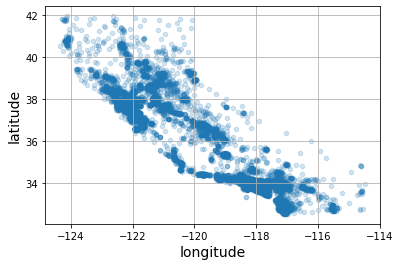
housing.plot(kind="scatter",
x="longitude",
y="latitude",
grid=True,
s=housing["population"] / 100,
label="population",
c="median_house_value",
cmap="jet",
colorbar=True,
legend=True,
sharex=False,
figsize=(10, 7)
);
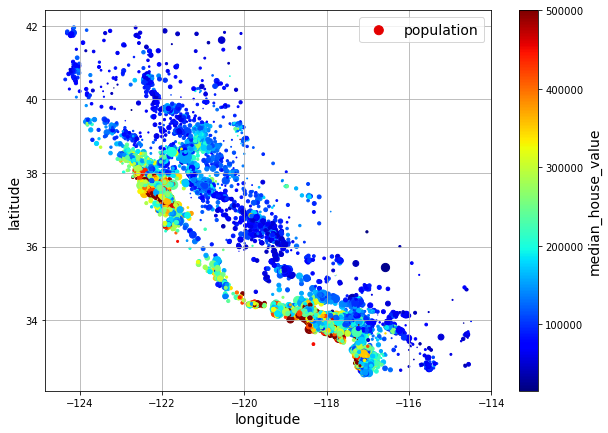
The argument sharex=False fixes a display bug: without it, the x-axis values and label are not displayed (see: https://github.com/pandas-dev/pandas/issues/10611).
Correlations#
corr_matrix = housing.corr()
corr_matrix["median_house_value"].sort_values(ascending=False)
median_house_value 1.000000
median_income 0.688380
total_rooms 0.137455
housing_median_age 0.102175
households 0.071426
total_bedrooms 0.054635
population -0.020153
longitude -0.050859
latitude -0.139584
Name: median_house_value, dtype: float64
attributes = ["median_house_value", "median_income", "total_rooms", "housing_median_age"]
scatter_matrix(housing[attributes], figsize=(12, 8));
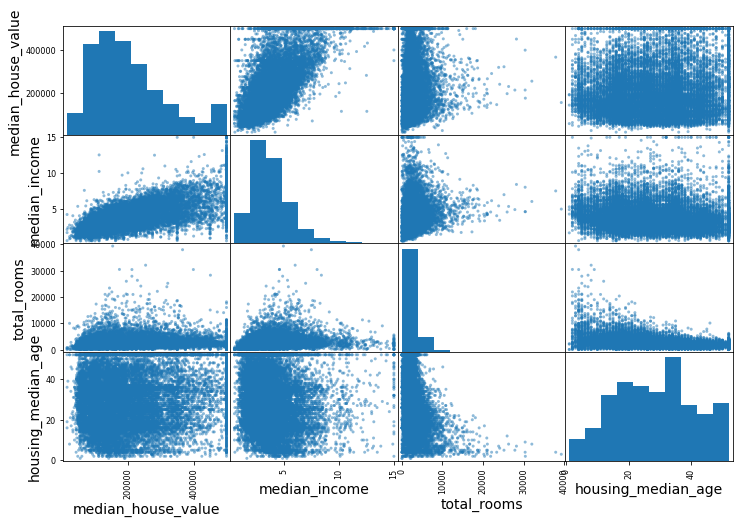
housing.plot(kind="scatter",
x="median_income",
y="median_house_value",
alpha=0.1,
grid=True,
figsize=(12, 8));
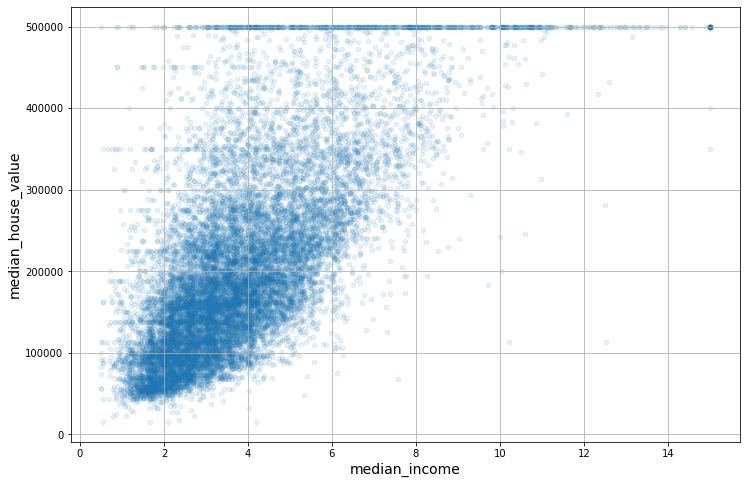
Feature Engineering#
Experimenting with Attribute Combinations
housing["rooms_per_house"] = housing["total_rooms"] / housing["households"]
housing["bedrooms_ratio"] = housing["total_bedrooms"] / housing["total_rooms"]
housing["people_per_house"] = housing["population"] / housing["households"]
corr_matrix = housing.corr()
corr_matrix["median_house_value"].sort_values(ascending=False)
median_house_value 1.000000
median_income 0.688380
rooms_per_house 0.143663
total_rooms 0.137455
housing_median_age 0.102175
households 0.071426
total_bedrooms 0.054635
population -0.020153
people_per_house -0.038224
longitude -0.050859
latitude -0.139584
bedrooms_ratio -0.256397
Name: median_house_value, dtype: float64
Data Pipeline#
Let’s revert to the original training set and separate the target (note that strat_train_set.drop() creates a copy of strat_train_set without the column, it doesn’t actually modify strat_train_set itself, unless you pass inplace=True):
housing = strat_train_set.drop("median_house_value", axis=1)
housing_labels = strat_train_set["median_house_value"].copy()
Now let’s build a pipeline to preprocess the attributes:
num_attribs = ["longitude", "latitude", "housing_median_age", "total_rooms",
"total_bedrooms", "population", "households", "median_income"]
cat_attribs = ["ocean_proximity"]
from sklearn.pipeline import make_pipeline
from sklearn.impute import SimpleImputer
from sklearn.preprocessing import OneHotEncoder
# categorical pipeline
cat_pipeline = make_pipeline(
SimpleImputer(strategy="most_frequent"),
OneHotEncoder(handle_unknown="ignore")
)
# default numerical pipeline
from sklearn.preprocessing import StandardScaler
default_num_pipeline = make_pipeline(
SimpleImputer(strategy="median"),
StandardScaler()
)
# custom function to make ratios
def column_ratio(X):
return X[:, [0]] / X[:, [1]]
from sklearn.preprocessing import FunctionTransformer
from sklearn.preprocessing import StandardScaler
# custom function to transfomr ratios
def ratio_pipeline(name=None):
return make_pipeline(
SimpleImputer(strategy="median"),
FunctionTransformer(column_ratio),
StandardScaler())
# custom log transformer
log_pipeline = make_pipeline(
SimpleImputer(strategy="median"),
FunctionTransformer(np.log),
StandardScaler())
To learn more about developing scikit-learn estimators, take a look at this page
Here is a template to build your own scikit-learn functions: template
# custom cluster similarity
from sklearn.cluster import KMeans
from sklearn.base import BaseEstimator, TransformerMixin
from sklearn.metrics.pairwise import rbf_kernel
class ClusterSimilarity(BaseEstimator, TransformerMixin):
def __init__(self, n_clusters=10, gamma=1.0, random_state=None):
self.n_clusters = n_clusters
self.gamma = gamma
self.random_state = random_state
def fit(self, X, y=None, sample_weight=None):
self.kmeans_ = KMeans(self.n_clusters, random_state=self.random_state)
self.kmeans_.fit(X, sample_weight=sample_weight)
return self # always return self!
def transform(self, X):
return rbf_kernel(X, self.kmeans_.cluster_centers_, gamma=self.gamma)
def get_feature_names_out(self, names=None):
return [f"Cluster {i} similarity" for i in range(self.n_clusters)]
# custom cluster similarity step
cluster_simil = ClusterSimilarity(n_clusters=10, gamma=1., random_state=42)
Perform transformations:
from sklearn.compose import ColumnTransformer
from sklearn.compose import make_column_selector
preprocessing = ColumnTransformer([
("bedrooms_ratio", ratio_pipeline("bedrooms_ratio"),
["total_bedrooms", "total_rooms"]),
("rooms_per_house", ratio_pipeline("rooms_per_house"),
["total_rooms", "households"]),
("people_per_house", ratio_pipeline("people_per_house"),
["population", "households"]),
("log", log_pipeline, ["total_bedrooms", "total_rooms",
"population", "households", "median_income"]),
("geo", cluster_simil, ["latitude", "longitude"]),
("cat", cat_pipeline, make_column_selector(dtype_include=object)),
],
remainder=default_num_pipeline) # one column remaining: housing_median_age
housing_prepared = preprocessing.fit_transform(housing)
housing_prepared.shape
(16512, 24)
Models#
Linear Regression#
from sklearn.linear_model import LinearRegression
lin_reg = make_pipeline(
preprocessing,
LinearRegression()
)
lin_reg.fit(housing, housing_labels)
Pipeline(steps=[('columntransformer',
ColumnTransformer(remainder=Pipeline(steps=[('simpleimputer',
SimpleImputer(strategy='median')),
('standardscaler',
StandardScaler())]),
transformers=[('bedrooms_ratio',
Pipeline(steps=[('simpleimputer',
SimpleImputer(strategy='median')),
('functiontransformer',
FunctionTransformer(func=<function column_ratio at 0x7fe110c0...
'median_income']),
('geo',
ClusterSimilarity(random_state=42),
['latitude', 'longitude']),
('cat',
Pipeline(steps=[('simpleimputer',
SimpleImputer(strategy='most_frequent')),
('onehotencoder',
OneHotEncoder(handle_unknown='ignore'))]),
<sklearn.compose._column_transformer.make_column_selector object at 0x7fe102252550>)])),
('linearregression', LinearRegression())])Please rerun this cell to show the HTML repr or trust the notebook.Pipeline(steps=[('columntransformer',
ColumnTransformer(remainder=Pipeline(steps=[('simpleimputer',
SimpleImputer(strategy='median')),
('standardscaler',
StandardScaler())]),
transformers=[('bedrooms_ratio',
Pipeline(steps=[('simpleimputer',
SimpleImputer(strategy='median')),
('functiontransformer',
FunctionTransformer(func=<function column_ratio at 0x7fe110c0...
'median_income']),
('geo',
ClusterSimilarity(random_state=42),
['latitude', 'longitude']),
('cat',
Pipeline(steps=[('simpleimputer',
SimpleImputer(strategy='most_frequent')),
('onehotencoder',
OneHotEncoder(handle_unknown='ignore'))]),
<sklearn.compose._column_transformer.make_column_selector object at 0x7fe102252550>)])),
('linearregression', LinearRegression())])ColumnTransformer(remainder=Pipeline(steps=[('simpleimputer',
SimpleImputer(strategy='median')),
('standardscaler',
StandardScaler())]),
transformers=[('bedrooms_ratio',
Pipeline(steps=[('simpleimputer',
SimpleImputer(strategy='median')),
('functiontransformer',
FunctionTransformer(func=<function column_ratio at 0x7fe110c04ee0>)),
('standardscaler',
StandardSca...
['total_bedrooms', 'total_rooms', 'population',
'households', 'median_income']),
('geo', ClusterSimilarity(random_state=42),
['latitude', 'longitude']),
('cat',
Pipeline(steps=[('simpleimputer',
SimpleImputer(strategy='most_frequent')),
('onehotencoder',
OneHotEncoder(handle_unknown='ignore'))]),
<sklearn.compose._column_transformer.make_column_selector object at 0x7fe102252550>)])['total_bedrooms', 'total_rooms']
SimpleImputer(strategy='median')
FunctionTransformer(func=<function column_ratio at 0x7fe110c04ee0>)
StandardScaler()
['total_rooms', 'households']
SimpleImputer(strategy='median')
FunctionTransformer(func=<function column_ratio at 0x7fe110c04ee0>)
StandardScaler()
['population', 'households']
SimpleImputer(strategy='median')
FunctionTransformer(func=<function column_ratio at 0x7fe110c04ee0>)
StandardScaler()
['total_bedrooms', 'total_rooms', 'population', 'households', 'median_income']
SimpleImputer(strategy='median')
FunctionTransformer(func=<ufunc 'log'>)
StandardScaler()
['latitude', 'longitude']
ClusterSimilarity(random_state=42)
<sklearn.compose._column_transformer.make_column_selector object at 0x7fe102252550>
SimpleImputer(strategy='most_frequent')
OneHotEncoder(handle_unknown='ignore')
['housing_median_age']
SimpleImputer(strategy='median')
StandardScaler()
LinearRegression()
housing_predictions = lin_reg.predict(housing)
from sklearn.metrics import mean_squared_error
lin_rmse = mean_squared_error(housing_labels, housing_predictions,
squared=False)
lin_rmse
68687.89176590106
Let’s try the full preprocessing pipeline on a few training instances:
housing_predictions[:5].round(-2) # -2 = rounded to the nearest hundred
array([243700., 372400., 128800., 94400., 328300.])
Compare against the actual values:
housing_labels.iloc[:5].values
array([458300., 483800., 101700., 96100., 361800.])
# extra code – computes the error ratios discussed in the book
error_ratios = housing_predictions[:5].round(-2) / housing_labels.iloc[:5].values - 1
print(", ".join([f"{100 * ratio:.1f}%" for ratio in error_ratios]))
-46.8%, -23.0%, 26.6%, -1.8%, -9.3%
Decision Tree#
from sklearn.tree import DecisionTreeRegressor
tree_reg = make_pipeline(
preprocessing,
DecisionTreeRegressor(random_state=42)
)
tree_reg.fit(housing, housing_labels)
Pipeline(steps=[('columntransformer',
ColumnTransformer(remainder=Pipeline(steps=[('simpleimputer',
SimpleImputer(strategy='median')),
('standardscaler',
StandardScaler())]),
transformers=[('bedrooms_ratio',
Pipeline(steps=[('simpleimputer',
SimpleImputer(strategy='median')),
('functiontransformer',
FunctionTransformer(func=<function column_ratio at 0x7fe110c0...
ClusterSimilarity(random_state=42),
['latitude', 'longitude']),
('cat',
Pipeline(steps=[('simpleimputer',
SimpleImputer(strategy='most_frequent')),
('onehotencoder',
OneHotEncoder(handle_unknown='ignore'))]),
<sklearn.compose._column_transformer.make_column_selector object at 0x7fe102252550>)])),
('decisiontreeregressor',
DecisionTreeRegressor(random_state=42))])Please rerun this cell to show the HTML repr or trust the notebook.Pipeline(steps=[('columntransformer',
ColumnTransformer(remainder=Pipeline(steps=[('simpleimputer',
SimpleImputer(strategy='median')),
('standardscaler',
StandardScaler())]),
transformers=[('bedrooms_ratio',
Pipeline(steps=[('simpleimputer',
SimpleImputer(strategy='median')),
('functiontransformer',
FunctionTransformer(func=<function column_ratio at 0x7fe110c0...
ClusterSimilarity(random_state=42),
['latitude', 'longitude']),
('cat',
Pipeline(steps=[('simpleimputer',
SimpleImputer(strategy='most_frequent')),
('onehotencoder',
OneHotEncoder(handle_unknown='ignore'))]),
<sklearn.compose._column_transformer.make_column_selector object at 0x7fe102252550>)])),
('decisiontreeregressor',
DecisionTreeRegressor(random_state=42))])ColumnTransformer(remainder=Pipeline(steps=[('simpleimputer',
SimpleImputer(strategy='median')),
('standardscaler',
StandardScaler())]),
transformers=[('bedrooms_ratio',
Pipeline(steps=[('simpleimputer',
SimpleImputer(strategy='median')),
('functiontransformer',
FunctionTransformer(func=<function column_ratio at 0x7fe110c04ee0>)),
('standardscaler',
StandardSca...
['total_bedrooms', 'total_rooms', 'population',
'households', 'median_income']),
('geo', ClusterSimilarity(random_state=42),
['latitude', 'longitude']),
('cat',
Pipeline(steps=[('simpleimputer',
SimpleImputer(strategy='most_frequent')),
('onehotencoder',
OneHotEncoder(handle_unknown='ignore'))]),
<sklearn.compose._column_transformer.make_column_selector object at 0x7fe102252550>)])['total_bedrooms', 'total_rooms']
SimpleImputer(strategy='median')
FunctionTransformer(func=<function column_ratio at 0x7fe110c04ee0>)
StandardScaler()
['total_rooms', 'households']
SimpleImputer(strategy='median')
FunctionTransformer(func=<function column_ratio at 0x7fe110c04ee0>)
StandardScaler()
['population', 'households']
SimpleImputer(strategy='median')
FunctionTransformer(func=<function column_ratio at 0x7fe110c04ee0>)
StandardScaler()
['total_bedrooms', 'total_rooms', 'population', 'households', 'median_income']
SimpleImputer(strategy='median')
FunctionTransformer(func=<ufunc 'log'>)
StandardScaler()
['latitude', 'longitude']
ClusterSimilarity(random_state=42)
<sklearn.compose._column_transformer.make_column_selector object at 0x7fe102252550>
SimpleImputer(strategy='most_frequent')
OneHotEncoder(handle_unknown='ignore')
['housing_median_age']
SimpleImputer(strategy='median')
StandardScaler()
DecisionTreeRegressor(random_state=42)
housing_predictions = tree_reg.predict(housing)
tree_rmse = mean_squared_error(housing_labels, housing_predictions,
squared=False)
tree_rmse
0.0
Cross-Validation#
Decision Tree#
from sklearn.model_selection import cross_val_score
# we only use cv=3 instead of cv=10 to speed up the computation
tree_rmses = -cross_val_score(tree_reg, housing, housing_labels,
scoring="neg_root_mean_squared_error", cv=3)
pd.Series(tree_rmses).describe()
count 3.000000
mean 68282.891053
std 1486.492256
min 66810.075215
25% 67532.990434
50% 68255.905652
75% 69019.298971
max 69782.692291
dtype: float64
Linear Regression#
lin_rmses = -cross_val_score(lin_reg, housing, housing_labels,
scoring="neg_root_mean_squared_error", cv=3)
pd.Series(lin_rmses).describe()
count 3.000000
mean 69778.756842
std 1629.907725
min 67980.530959
25% 69088.686886
50% 70196.842814
75% 70677.869784
max 71158.896754
dtype: float64
Random Forest#
Again, we set cv=3 instead of cv=10:
from sklearn.ensemble import RandomForestRegressor
forest_reg = make_pipeline(preprocessing,
RandomForestRegressor(random_state=42))
forest_rmses = -cross_val_score(forest_reg, housing, housing_labels,
scoring="neg_root_mean_squared_error", cv=3)
pd.Series(forest_rmses).describe()
count 3.000000
mean 47889.465303
std 619.080587
min 47392.624982
25% 47542.700149
50% 47692.775316
75% 48137.885464
max 48582.995613
dtype: float64
Let’s compare this RMSE measured using cross-validation (the “validation error”) with the RMSE measured on the training set (the “training error”):
forest_reg.fit(housing, housing_labels)
housing_predictions = forest_reg.predict(housing)
forest_rmse = mean_squared_error(housing_labels, housing_predictions,
squared=False)
forest_rmse
17474.619286483998
The training error is much lower than the validation error, which usually means that the model has overfit the training set. Another possible explanation may be that there’s a mismatch between the training data and the validation data, but it’s not the case here, since both came from the same dataset that we shuffled and split in two parts.
Fine-Tuning#
Grid Search#
from sklearn.model_selection import GridSearchCV
from sklearn.pipeline import Pipeline
full_pipeline = Pipeline([
("preprocessing", preprocessing),
("random_forest", RandomForestRegressor(random_state=42)),
])
param_grid = [
{'preprocessing__geo__n_clusters': [5, 8, 10],
'random_forest__max_features': [4, 6, 8]},
{'preprocessing__geo__n_clusters': [10, 15],
'random_forest__max_features': [6, 8, 10]},
]
grid_search = GridSearchCV(full_pipeline, param_grid, cv=3,
scoring='neg_root_mean_squared_error')
Warning: the following cell may take a few minutes to run:
grid_search.fit(housing, housing_labels)
GridSearchCV(cv=3,
estimator=Pipeline(steps=[('preprocessing',
ColumnTransformer(remainder=Pipeline(steps=[('simpleimputer',
SimpleImputer(strategy='median')),
('standardscaler',
StandardScaler())]),
transformers=[('bedrooms_ratio',
Pipeline(steps=[('simpleimputer',
SimpleImputer(strategy='median')),
('functiontransformer',
FunctionTransformer(func=<function...
<sklearn.compose._column_transformer.make_column_selector object at 0x7fe102252550>)])),
('random_forest',
RandomForestRegressor(random_state=42))]),
param_grid=[{'preprocessing__geo__n_clusters': [5, 8, 10],
'random_forest__max_features': [4, 6, 8]},
{'preprocessing__geo__n_clusters': [10, 15],
'random_forest__max_features': [6, 8, 10]}],
scoring='neg_root_mean_squared_error')Please rerun this cell to show the HTML repr or trust the notebook.GridSearchCV(cv=3,
estimator=Pipeline(steps=[('preprocessing',
ColumnTransformer(remainder=Pipeline(steps=[('simpleimputer',
SimpleImputer(strategy='median')),
('standardscaler',
StandardScaler())]),
transformers=[('bedrooms_ratio',
Pipeline(steps=[('simpleimputer',
SimpleImputer(strategy='median')),
('functiontransformer',
FunctionTransformer(func=<function...
<sklearn.compose._column_transformer.make_column_selector object at 0x7fe102252550>)])),
('random_forest',
RandomForestRegressor(random_state=42))]),
param_grid=[{'preprocessing__geo__n_clusters': [5, 8, 10],
'random_forest__max_features': [4, 6, 8]},
{'preprocessing__geo__n_clusters': [10, 15],
'random_forest__max_features': [6, 8, 10]}],
scoring='neg_root_mean_squared_error')ColumnTransformer(remainder=Pipeline(steps=[('simpleimputer',
SimpleImputer(strategy='median')),
('standardscaler',
StandardScaler())]),
transformers=[('bedrooms_ratio',
Pipeline(steps=[('simpleimputer',
SimpleImputer(strategy='median')),
('functiontransformer',
FunctionTransformer(func=<function column_ratio at 0x7fe110c04ee0>)),
('standardscaler',
StandardSca...
['total_bedrooms', 'total_rooms', 'population',
'households', 'median_income']),
('geo', ClusterSimilarity(random_state=42),
['latitude', 'longitude']),
('cat',
Pipeline(steps=[('simpleimputer',
SimpleImputer(strategy='most_frequent')),
('onehotencoder',
OneHotEncoder(handle_unknown='ignore'))]),
<sklearn.compose._column_transformer.make_column_selector object at 0x7fe102252550>)])['total_bedrooms', 'total_rooms']
SimpleImputer(strategy='median')
FunctionTransformer(func=<function column_ratio at 0x7fe110c04ee0>)
StandardScaler()
['total_rooms', 'households']
SimpleImputer(strategy='median')
FunctionTransformer(func=<function column_ratio at 0x7fe110c04ee0>)
StandardScaler()
['population', 'households']
SimpleImputer(strategy='median')
FunctionTransformer(func=<function column_ratio at 0x7fe110c04ee0>)
StandardScaler()
['total_bedrooms', 'total_rooms', 'population', 'households', 'median_income']
SimpleImputer(strategy='median')
FunctionTransformer(func=<ufunc 'log'>)
StandardScaler()
['latitude', 'longitude']
ClusterSimilarity(random_state=42)
<sklearn.compose._column_transformer.make_column_selector object at 0x7fe102252550>
SimpleImputer(strategy='most_frequent')
OneHotEncoder(handle_unknown='ignore')
['housing_median_age']
SimpleImputer(strategy='median')
StandardScaler()
RandomForestRegressor(random_state=42)
You can get the full list of hyperparameters available for tuning by looking at full_pipeline.get_params().keys():
# extra code – shows part of the output of get_params().keys()
print(str(full_pipeline.get_params().keys())[:1000] + "...")
dict_keys(['memory', 'steps', 'verbose', 'preprocessing', 'random_forest', 'preprocessing__n_jobs', 'preprocessing__remainder__memory', 'preprocessing__remainder__steps', 'preprocessing__remainder__verbose', 'preprocessing__remainder__simpleimputer', 'preprocessing__remainder__standardscaler', 'preprocessing__remainder__simpleimputer__add_indicator', 'preprocessing__remainder__simpleimputer__copy', 'preprocessing__remainder__simpleimputer__fill_value', 'preprocessing__remainder__simpleimputer__missing_values', 'preprocessing__remainder__simpleimputer__strategy', 'preprocessing__remainder__simpleimputer__verbose', 'preprocessing__remainder__standardscaler__copy', 'preprocessing__remainder__standardscaler__with_mean', 'preprocessing__remainder__standardscaler__with_std', 'preprocessing__remainder', 'preprocessing__sparse_threshold', 'preprocessing__transformer_weights', 'preprocessing__transformers', 'preprocessing__verbose', 'preprocessing__verbose_feature_names_out', 'preprocessing__be...
The best hyperparameter combination found:
grid_search.best_params_
{'preprocessing__geo__n_clusters': 15, 'random_forest__max_features': 6}
grid_search.best_estimator_
Pipeline(steps=[('preprocessing',
ColumnTransformer(remainder=Pipeline(steps=[('simpleimputer',
SimpleImputer(strategy='median')),
('standardscaler',
StandardScaler())]),
transformers=[('bedrooms_ratio',
Pipeline(steps=[('simpleimputer',
SimpleImputer(strategy='median')),
('functiontransformer',
FunctionTransformer(func=<function column_ratio at 0x7fe110c04ee0...
ClusterSimilarity(n_clusters=15,
random_state=42),
['latitude', 'longitude']),
('cat',
Pipeline(steps=[('simpleimputer',
SimpleImputer(strategy='most_frequent')),
('onehotencoder',
OneHotEncoder(handle_unknown='ignore'))]),
<sklearn.compose._column_transformer.make_column_selector object at 0x7fe0f0a228e0>)])),
('random_forest',
RandomForestRegressor(max_features=6, random_state=42))])Please rerun this cell to show the HTML repr or trust the notebook.Pipeline(steps=[('preprocessing',
ColumnTransformer(remainder=Pipeline(steps=[('simpleimputer',
SimpleImputer(strategy='median')),
('standardscaler',
StandardScaler())]),
transformers=[('bedrooms_ratio',
Pipeline(steps=[('simpleimputer',
SimpleImputer(strategy='median')),
('functiontransformer',
FunctionTransformer(func=<function column_ratio at 0x7fe110c04ee0...
ClusterSimilarity(n_clusters=15,
random_state=42),
['latitude', 'longitude']),
('cat',
Pipeline(steps=[('simpleimputer',
SimpleImputer(strategy='most_frequent')),
('onehotencoder',
OneHotEncoder(handle_unknown='ignore'))]),
<sklearn.compose._column_transformer.make_column_selector object at 0x7fe0f0a228e0>)])),
('random_forest',
RandomForestRegressor(max_features=6, random_state=42))])ColumnTransformer(remainder=Pipeline(steps=[('simpleimputer',
SimpleImputer(strategy='median')),
('standardscaler',
StandardScaler())]),
transformers=[('bedrooms_ratio',
Pipeline(steps=[('simpleimputer',
SimpleImputer(strategy='median')),
('functiontransformer',
FunctionTransformer(func=<function column_ratio at 0x7fe110c04ee0>)),
('standardscaler',
StandardSca...
['total_bedrooms', 'total_rooms', 'population',
'households', 'median_income']),
('geo',
ClusterSimilarity(n_clusters=15,
random_state=42),
['latitude', 'longitude']),
('cat',
Pipeline(steps=[('simpleimputer',
SimpleImputer(strategy='most_frequent')),
('onehotencoder',
OneHotEncoder(handle_unknown='ignore'))]),
<sklearn.compose._column_transformer.make_column_selector object at 0x7fe0f0a228e0>)])['total_bedrooms', 'total_rooms']
SimpleImputer(strategy='median')
FunctionTransformer(func=<function column_ratio at 0x7fe110c04ee0>)
StandardScaler()
['total_rooms', 'households']
SimpleImputer(strategy='median')
FunctionTransformer(func=<function column_ratio at 0x7fe110c04ee0>)
StandardScaler()
['population', 'households']
SimpleImputer(strategy='median')
FunctionTransformer(func=<function column_ratio at 0x7fe110c04ee0>)
StandardScaler()
['total_bedrooms', 'total_rooms', 'population', 'households', 'median_income']
SimpleImputer(strategy='median')
FunctionTransformer(func=<ufunc 'log'>)
StandardScaler()
['latitude', 'longitude']
ClusterSimilarity(n_clusters=15, random_state=42)
<sklearn.compose._column_transformer.make_column_selector object at 0x7fe0f0a228e0>
SimpleImputer(strategy='most_frequent')
OneHotEncoder(handle_unknown='ignore')
['housing_median_age']
SimpleImputer(strategy='median')
StandardScaler()
RandomForestRegressor(max_features=6, random_state=42)
Let’s look at the score of each hyperparameter combination tested during the grid search:
cv_res = pd.DataFrame(grid_search.cv_results_)
cv_res.sort_values(by="mean_test_score", ascending=False, inplace=True)
# extra code – these few lines of code just make the DataFrame look nicer
cv_res = cv_res[["param_preprocessing__geo__n_clusters",
"param_random_forest__max_features", "split0_test_score",
"split1_test_score", "split2_test_score", "mean_test_score"]]
score_cols = ["split0", "split1", "split2", "mean_test_rmse"]
cv_res.columns = ["n_clusters", "max_features"] + score_cols
cv_res[score_cols] = -cv_res[score_cols].round().astype(np.int64)
cv_res.head()
| n_clusters | max_features | split0 | split1 | split2 | mean_test_rmse | |
|---|---|---|---|---|---|---|
| 12 | 15 | 6 | 43460 | 43919 | 44748 | 44042 |
| 13 | 15 | 8 | 44132 | 44075 | 45010 | 44406 |
| 14 | 15 | 10 | 44374 | 44286 | 45316 | 44659 |
| 7 | 10 | 6 | 44683 | 44655 | 45657 | 44999 |
| 9 | 10 | 6 | 44683 | 44655 | 45657 | 44999 |
Randomized Search#
from sklearn.experimental import enable_halving_search_cv
from sklearn.model_selection import HalvingRandomSearchCV
Warning: the following cell may take a few minutes to run:
Try 30 (n_iter × cv) random combinations of hyperparameters:
from sklearn.model_selection import RandomizedSearchCV
from scipy.stats import randint
param_distribs = {'preprocessing__geo__n_clusters': randint(low=3, high=10),
'random_forest__max_features': randint(low=2, high=10)}
rnd_search = RandomizedSearchCV(
full_pipeline, param_distributions=param_distribs, n_iter=10, cv=3,
scoring='neg_root_mean_squared_error', random_state=42)
rnd_search.fit(housing, housing_labels)
RandomizedSearchCV(cv=3,
estimator=Pipeline(steps=[('preprocessing',
ColumnTransformer(remainder=Pipeline(steps=[('simpleimputer',
SimpleImputer(strategy='median')),
('standardscaler',
StandardScaler())]),
transformers=[('bedrooms_ratio',
Pipeline(steps=[('simpleimputer',
SimpleImputer(strategy='median')),
('functiontransformer',
FunctionTransformer(func=<fu...
<sklearn.compose._column_transformer.make_column_selector object at 0x7fe102252550>)])),
('random_forest',
RandomForestRegressor(random_state=42))]),
param_distributions={'preprocessing__geo__n_clusters': <scipy.stats._distn_infrastructure.rv_frozen object at 0x7fe101e9d0a0>,
'random_forest__max_features': <scipy.stats._distn_infrastructure.rv_frozen object at 0x7fe101f2dd30>},
random_state=42, scoring='neg_root_mean_squared_error')Please rerun this cell to show the HTML repr or trust the notebook.RandomizedSearchCV(cv=3,
estimator=Pipeline(steps=[('preprocessing',
ColumnTransformer(remainder=Pipeline(steps=[('simpleimputer',
SimpleImputer(strategy='median')),
('standardscaler',
StandardScaler())]),
transformers=[('bedrooms_ratio',
Pipeline(steps=[('simpleimputer',
SimpleImputer(strategy='median')),
('functiontransformer',
FunctionTransformer(func=<fu...
<sklearn.compose._column_transformer.make_column_selector object at 0x7fe102252550>)])),
('random_forest',
RandomForestRegressor(random_state=42))]),
param_distributions={'preprocessing__geo__n_clusters': <scipy.stats._distn_infrastructure.rv_frozen object at 0x7fe101e9d0a0>,
'random_forest__max_features': <scipy.stats._distn_infrastructure.rv_frozen object at 0x7fe101f2dd30>},
random_state=42, scoring='neg_root_mean_squared_error')ColumnTransformer(remainder=Pipeline(steps=[('simpleimputer',
SimpleImputer(strategy='median')),
('standardscaler',
StandardScaler())]),
transformers=[('bedrooms_ratio',
Pipeline(steps=[('simpleimputer',
SimpleImputer(strategy='median')),
('functiontransformer',
FunctionTransformer(func=<function column_ratio at 0x7fe110c04ee0>)),
('standardscaler',
StandardSca...
['total_bedrooms', 'total_rooms', 'population',
'households', 'median_income']),
('geo', ClusterSimilarity(random_state=42),
['latitude', 'longitude']),
('cat',
Pipeline(steps=[('simpleimputer',
SimpleImputer(strategy='most_frequent')),
('onehotencoder',
OneHotEncoder(handle_unknown='ignore'))]),
<sklearn.compose._column_transformer.make_column_selector object at 0x7fe102252550>)])['total_bedrooms', 'total_rooms']
SimpleImputer(strategy='median')
FunctionTransformer(func=<function column_ratio at 0x7fe110c04ee0>)
StandardScaler()
['total_rooms', 'households']
SimpleImputer(strategy='median')
FunctionTransformer(func=<function column_ratio at 0x7fe110c04ee0>)
StandardScaler()
['population', 'households']
SimpleImputer(strategy='median')
FunctionTransformer(func=<function column_ratio at 0x7fe110c04ee0>)
StandardScaler()
['total_bedrooms', 'total_rooms', 'population', 'households', 'median_income']
SimpleImputer(strategy='median')
FunctionTransformer(func=<ufunc 'log'>)
StandardScaler()
['latitude', 'longitude']
ClusterSimilarity(random_state=42)
<sklearn.compose._column_transformer.make_column_selector object at 0x7fe102252550>
SimpleImputer(strategy='most_frequent')
OneHotEncoder(handle_unknown='ignore')
['housing_median_age']
SimpleImputer(strategy='median')
StandardScaler()
RandomForestRegressor(random_state=42)
# extra code – displays the random search results
cv_res = pd.DataFrame(rnd_search.cv_results_)
cv_res.sort_values(by="mean_test_score", ascending=False, inplace=True)
cv_res = cv_res[["param_preprocessing__geo__n_clusters",
"param_random_forest__max_features", "split0_test_score",
"split1_test_score", "split2_test_score", "mean_test_score"]]
cv_res.columns = ["n_clusters", "max_features"] + score_cols
cv_res[score_cols] = -cv_res[score_cols].round().astype(np.int64)
cv_res.head()
| n_clusters | max_features | split0 | split1 | split2 | mean_test_rmse | |
|---|---|---|---|---|---|---|
| 0 | 9 | 5 | 45311 | 44727 | 46099 | 45379 |
| 4 | 9 | 3 | 45721 | 45397 | 46743 | 45953 |
| 7 | 7 | 5 | 45887 | 45597 | 46504 | 45996 |
| 3 | 7 | 6 | 45633 | 45815 | 46702 | 46050 |
| 1 | 7 | 8 | 45887 | 45820 | 46809 | 46172 |
Analyze Errors#
Analyze Errors of Best Model
final_model = rnd_search.best_estimator_ # includes preprocessing
feature_importances = final_model["random_forest"].feature_importances_
feature_importances.round(2)
array([0.08, 0.06, 0.08, 0.01, 0.01, 0.01, 0.01, 0.25, 0.04, 0.03, 0.04,
0.03, 0.04, 0.06, 0.02, 0.03, 0.02, 0.01, 0.12, 0. , 0. , 0.01,
0.03])
Evaluate on Test Set#
X_test = strat_test_set.drop("median_house_value", axis=1)
y_test = strat_test_set["median_house_value"].copy()
final_predictions = final_model.predict(X_test)
final_rmse = mean_squared_error(y_test, final_predictions, squared=False)
print(final_rmse)
44556.01747258438
We can compute a 95% confidence interval for the test RMSE:
from scipy import stats
confidence = 0.95
squared_errors = (final_predictions - y_test) ** 2
np.sqrt(stats.t.interval(confidence, len(squared_errors) - 1,
loc=squared_errors.mean(),
scale=stats.sem(squared_errors)))
array([42373.48736315, 46636.51953908])
Save model#
Model persistence using joblib
Save the final model:
import joblib
joblib.dump(final_model, "my_california_housing_model.pkl")
['my_california_housing_model.pkl']
Now you can deploy this model to production. For example, the following code could be a script that would run in production:
final_model_reloaded = joblib.load("my_california_housing_model.pkl")
new_data = housing.iloc[:5] # pretend these are new districts
predictions = final_model_reloaded.predict(new_data)
predictions
array([429545.11 , 462980.09 , 108348.47761194, 99628. ,
345977.07 ])
Exercise solutions#
1. Support Vector Machine#
Exercise: Try a Support Vector Machine regressor (sklearn.svm.SVR) with various hyperparameters, such as kernel="linear" (with various values for the C hyperparameter) or kernel="rbf" (with various values for the C and gamma hyperparameters). Note that SVMs don’t scale well to large datasets, so you should probably train your model on just the first 5,000 instances of the training set and use only 3-fold cross-validation, or else it will take hours. Don’t worry about what the hyperparameters mean for now (see the SVM notebook if you’re interested). How does the best SVR predictor perform?
from sklearn.model_selection import GridSearchCV
from sklearn.svm import SVR
param_grid = [
{'svr__kernel': ['linear'], 'svr__C': [10., 30., 100., 300., 1000.,
3000., 10000., 30000.0]},
{'svr__kernel': ['rbf'], 'svr__C': [1.0, 3.0, 10., 30., 100., 300.,
1000.0],
'svr__gamma': [0.01, 0.03, 0.1, 0.3, 1.0, 3.0]},
]
svr_pipeline = Pipeline([("preprocessing", preprocessing), ("svr", SVR())])
grid_search = GridSearchCV(svr_pipeline, param_grid, cv=3,
scoring='neg_root_mean_squared_error')
grid_search.fit(housing.iloc[:5000], housing_labels.iloc[:5000])
GridSearchCV(cv=3,
estimator=Pipeline(steps=[('preprocessing',
ColumnTransformer(remainder=Pipeline(steps=[('simpleimputer',
SimpleImputer(strategy='median')),
('standardscaler',
StandardScaler())]),
transformers=[('bedrooms_ratio',
Pipeline(steps=[('simpleimputer',
SimpleImputer(strategy='median')),
('functiontransformer',
FunctionTransformer(feature_names_...
<sklearn.compose._column_transformer.make_column_selector object at 0x14869da30>)])),
('svr', SVR())]),
param_grid=[{'svr__C': [10.0, 30.0, 100.0, 300.0, 1000.0, 3000.0,
10000.0, 30000.0],
'svr__kernel': ['linear']},
{'svr__C': [1.0, 3.0, 10.0, 30.0, 100.0, 300.0,
1000.0],
'svr__gamma': [0.01, 0.03, 0.1, 0.3, 1.0, 3.0],
'svr__kernel': ['rbf']}],
scoring='neg_root_mean_squared_error')In a Jupyter environment, please rerun this cell to show the HTML representation or trust the notebook. On GitHub, the HTML representation is unable to render, please try loading this page with nbviewer.org.
GridSearchCV(cv=3,
estimator=Pipeline(steps=[('preprocessing',
ColumnTransformer(remainder=Pipeline(steps=[('simpleimputer',
SimpleImputer(strategy='median')),
('standardscaler',
StandardScaler())]),
transformers=[('bedrooms_ratio',
Pipeline(steps=[('simpleimputer',
SimpleImputer(strategy='median')),
('functiontransformer',
FunctionTransformer(feature_names_...
<sklearn.compose._column_transformer.make_column_selector object at 0x14869da30>)])),
('svr', SVR())]),
param_grid=[{'svr__C': [10.0, 30.0, 100.0, 300.0, 1000.0, 3000.0,
10000.0, 30000.0],
'svr__kernel': ['linear']},
{'svr__C': [1.0, 3.0, 10.0, 30.0, 100.0, 300.0,
1000.0],
'svr__gamma': [0.01, 0.03, 0.1, 0.3, 1.0, 3.0],
'svr__kernel': ['rbf']}],
scoring='neg_root_mean_squared_error')Pipeline(steps=[('preprocessing',
ColumnTransformer(remainder=Pipeline(steps=[('simpleimputer',
SimpleImputer(strategy='median')),
('standardscaler',
StandardScaler())]),
transformers=[('bedrooms_ratio',
Pipeline(steps=[('simpleimputer',
SimpleImputer(strategy='median')),
('functiontransformer',
FunctionTransformer(feature_names_out=['bedrooms_ratio'],
func=...
'total_rooms', 'population',
'households',
'median_income']),
('geo',
ClusterSimilarity(random_state=42),
['latitude', 'longitude']),
('cat',
Pipeline(steps=[('simpleimputer',
SimpleImputer(strategy='most_frequent')),
('onehotencoder',
OneHotEncoder(handle_unknown='ignore'))]),
<sklearn.compose._column_transformer.make_column_selector object at 0x14869da30>)])),
('svr', SVR())])ColumnTransformer(remainder=Pipeline(steps=[('simpleimputer',
SimpleImputer(strategy='median')),
('standardscaler',
StandardScaler())]),
transformers=[('bedrooms_ratio',
Pipeline(steps=[('simpleimputer',
SimpleImputer(strategy='median')),
('functiontransformer',
FunctionTransformer(feature_names_out=['bedrooms_ratio'],
func=<function column_ratio at 0x1490f967...
['total_bedrooms', 'total_rooms', 'population',
'households', 'median_income']),
('geo', ClusterSimilarity(random_state=42),
['latitude', 'longitude']),
('cat',
Pipeline(steps=[('simpleimputer',
SimpleImputer(strategy='most_frequent')),
('onehotencoder',
OneHotEncoder(handle_unknown='ignore'))]),
<sklearn.compose._column_transformer.make_column_selector object at 0x14869da30>)])['total_bedrooms', 'total_rooms']
SimpleImputer(strategy='median')
FunctionTransformer(feature_names_out=['bedrooms_ratio'],
func=<function column_ratio at 0x1490f9670>)StandardScaler()
['total_rooms', 'households']
SimpleImputer(strategy='median')
FunctionTransformer(feature_names_out=['rooms_per_house'],
func=<function column_ratio at 0x1490f9670>)StandardScaler()
['population', 'households']
SimpleImputer(strategy='median')
FunctionTransformer(feature_names_out=['people_per_house'],
func=<function column_ratio at 0x1490f9670>)StandardScaler()
['total_bedrooms', 'total_rooms', 'population', 'households', 'median_income']
SimpleImputer(strategy='median')
FunctionTransformer(func=<ufunc 'log'>)
StandardScaler()
['latitude', 'longitude']
ClusterSimilarity(random_state=42)
<sklearn.compose._column_transformer.make_column_selector object at 0x14869da30>
SimpleImputer(strategy='most_frequent')
OneHotEncoder(handle_unknown='ignore')
['housing_median_age']
SimpleImputer(strategy='median')
StandardScaler()
SVR()
The best model achieves the following score (evaluated using 3-fold cross validation):
svr_grid_search_rmse = -grid_search.best_score_
svr_grid_search_rmse
69814.13889099036
That’s much worse than the RandomForestRegressor (but to be fair, we trained the model on much less data). Let’s check the best hyperparameters found:
grid_search.best_params_
{'svr__C': 10000.0, 'svr__kernel': 'linear'}
The linear kernel seems better than the RBF kernel. Notice that the value of C is the maximum tested value. When this happens you definitely want to launch the grid search again with higher values for C (removing the smallest values), because it is likely that higher values of C will be better.
2. Randomized Search CV#
Exercise: Try replacing the GridSearchCV with a RandomizedSearchCV.
Warning: the following cell will take several minutes to run. You can specify verbose=2 when creating the RandomizedSearchCV if you want to see the training details.
from sklearn.model_selection import RandomizedSearchCV
from scipy.stats import expon, reciprocal
# see https://docs.scipy.org/doc/scipy/reference/stats.html
# for `expon()` and `reciprocal()` documentation and more probability distribution functions.
# Note: gamma is ignored when kernel is "linear"
param_distribs = {
'svr__kernel': ['linear', 'rbf'],
'svr__C': reciprocal(20, 200_000),
'svr__gamma': expon(scale=1.0),
}
# we set n_iter to 10
rnd_search = RandomizedSearchCV(svr_pipeline,
param_distributions=param_distribs,
n_iter=10, cv=3,
scoring='neg_root_mean_squared_error',
random_state=42)
rnd_search.fit(housing.iloc[:5000], housing_labels.iloc[:5000])
RandomizedSearchCV(cv=3,
estimator=Pipeline(steps=[('preprocessing',
ColumnTransformer(remainder=Pipeline(steps=[('simpleimputer',
SimpleImputer(strategy='median')),
('standardscaler',
StandardScaler())]),
transformers=[('bedrooms_ratio',
Pipeline(steps=[('simpleimputer',
SimpleImputer(strategy='median')),
('functiontransformer',
FunctionTransformer(feature_...
<sklearn.compose._column_transformer.make_column_selector object at 0x14869da30>)])),
('svr', SVR())]),
param_distributions={'svr__C': <scipy.stats._distn_infrastructure.rv_frozen object at 0x149abd9d0>,
'svr__gamma': <scipy.stats._distn_infrastructure.rv_frozen object at 0x149a7c8e0>,
'svr__kernel': ['linear', 'rbf']},
random_state=42, scoring='neg_root_mean_squared_error')In a Jupyter environment, please rerun this cell to show the HTML representation or trust the notebook. On GitHub, the HTML representation is unable to render, please try loading this page with nbviewer.org.
RandomizedSearchCV(cv=3,
estimator=Pipeline(steps=[('preprocessing',
ColumnTransformer(remainder=Pipeline(steps=[('simpleimputer',
SimpleImputer(strategy='median')),
('standardscaler',
StandardScaler())]),
transformers=[('bedrooms_ratio',
Pipeline(steps=[('simpleimputer',
SimpleImputer(strategy='median')),
('functiontransformer',
FunctionTransformer(feature_...
<sklearn.compose._column_transformer.make_column_selector object at 0x14869da30>)])),
('svr', SVR())]),
param_distributions={'svr__C': <scipy.stats._distn_infrastructure.rv_frozen object at 0x149abd9d0>,
'svr__gamma': <scipy.stats._distn_infrastructure.rv_frozen object at 0x149a7c8e0>,
'svr__kernel': ['linear', 'rbf']},
random_state=42, scoring='neg_root_mean_squared_error')Pipeline(steps=[('preprocessing',
ColumnTransformer(remainder=Pipeline(steps=[('simpleimputer',
SimpleImputer(strategy='median')),
('standardscaler',
StandardScaler())]),
transformers=[('bedrooms_ratio',
Pipeline(steps=[('simpleimputer',
SimpleImputer(strategy='median')),
('functiontransformer',
FunctionTransformer(feature_names_out=['bedrooms_ratio'],
func=...
'total_rooms', 'population',
'households',
'median_income']),
('geo',
ClusterSimilarity(random_state=42),
['latitude', 'longitude']),
('cat',
Pipeline(steps=[('simpleimputer',
SimpleImputer(strategy='most_frequent')),
('onehotencoder',
OneHotEncoder(handle_unknown='ignore'))]),
<sklearn.compose._column_transformer.make_column_selector object at 0x14869da30>)])),
('svr', SVR())])ColumnTransformer(remainder=Pipeline(steps=[('simpleimputer',
SimpleImputer(strategy='median')),
('standardscaler',
StandardScaler())]),
transformers=[('bedrooms_ratio',
Pipeline(steps=[('simpleimputer',
SimpleImputer(strategy='median')),
('functiontransformer',
FunctionTransformer(feature_names_out=['bedrooms_ratio'],
func=<function column_ratio at 0x1490f967...
['total_bedrooms', 'total_rooms', 'population',
'households', 'median_income']),
('geo', ClusterSimilarity(random_state=42),
['latitude', 'longitude']),
('cat',
Pipeline(steps=[('simpleimputer',
SimpleImputer(strategy='most_frequent')),
('onehotencoder',
OneHotEncoder(handle_unknown='ignore'))]),
<sklearn.compose._column_transformer.make_column_selector object at 0x14869da30>)])['total_bedrooms', 'total_rooms']
SimpleImputer(strategy='median')
FunctionTransformer(feature_names_out=['bedrooms_ratio'],
func=<function column_ratio at 0x1490f9670>)StandardScaler()
['total_rooms', 'households']
SimpleImputer(strategy='median')
FunctionTransformer(feature_names_out=['rooms_per_house'],
func=<function column_ratio at 0x1490f9670>)StandardScaler()
['population', 'households']
SimpleImputer(strategy='median')
FunctionTransformer(feature_names_out=['people_per_house'],
func=<function column_ratio at 0x1490f9670>)StandardScaler()
['total_bedrooms', 'total_rooms', 'population', 'households', 'median_income']
SimpleImputer(strategy='median')
FunctionTransformer(func=<ufunc 'log'>)
StandardScaler()
['latitude', 'longitude']
ClusterSimilarity(random_state=42)
<sklearn.compose._column_transformer.make_column_selector object at 0x14869da30>
SimpleImputer(strategy='most_frequent')
OneHotEncoder(handle_unknown='ignore')
['housing_median_age']
SimpleImputer(strategy='median')
StandardScaler()
SVR()
The best model achieves the following score (evaluated using 3-fold cross validation):
svr_rnd_search_rmse = -rnd_search.best_score_
svr_rnd_search_rmse
55853.88099808542
Now that’s really much better, but still far from the RandomForestRegressor’s performance. Let’s check the best hyperparameters found:
rnd_search.best_params_
{'svr__C': 157055.10989448498,
'svr__gamma': 0.26497040005002437,
'svr__kernel': 'rbf'}
This time the search found a good set of hyperparameters for the RBF kernel. Randomized search tends to find better hyperparameters than grid search in the same amount of time.
Note that we used the expon() distribution for gamma, with a scale of 1, so RandomSearch mostly searched for values roughly of that scale: about 80% of the samples were between 0.1 and 2.3 (roughly 10% were smaller and 10% were larger):
np.random.seed(42)
s = expon(scale=1).rvs(100_000) # get 100,000 samples
((s > 0.105) & (s < 2.29)).sum() / 100_000
0.80066
We used the reciprocal() distribution for C, meaning we did not have a clue what the optimal scale of C was before running the random search. It explored the range from 20 to 200 just as much as the range from 2,000 to 20,000 or from 20,000 to 200,000.
3. SelectFromModel#
Exercise: Try adding a SelectFromModel transformer in the preparation pipeline to select only the most important attributes.
Let’s create a new pipeline that runs the previously defined preparation pipeline, and adds a SelectFromModel transformer based on a RandomForestRegressor before the final regressor:
from sklearn.feature_selection import SelectFromModel
selector_pipeline = Pipeline([
('preprocessing', preprocessing),
('selector', SelectFromModel(RandomForestRegressor(random_state=42),
threshold=0.005)), # min feature importance
('svr', SVR(C=rnd_search.best_params_["svr__C"],
gamma=rnd_search.best_params_["svr__gamma"],
kernel=rnd_search.best_params_["svr__kernel"])),
])
selector_rmses = -cross_val_score(selector_pipeline,
housing.iloc[:5000],
housing_labels.iloc[:5000],
scoring="neg_root_mean_squared_error",
cv=3)
pd.Series(selector_rmses).describe()
count 3.000000
mean 56211.362079
std 1922.002809
min 54150.008614
25% 55339.929900
50% 56529.851185
75% 57242.038812
max 57954.226438
dtype: float64
Oh well, feature selection does not seem to help. But maybe that’s just because the threshold we used was not optimal. Perhaps try tuning it using random search or grid search?
Congratulations! You already know quite a lot about Machine Learning. :)

